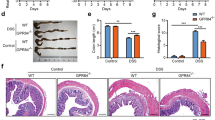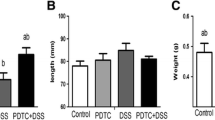Abstract
Peroxisome proliferator-activated receptors (PPARs) β/δ and γ have overlapping roles in the negative regulation of inflammatory response genes. Ligand activation of PPARγ protects against experimental colitis in mice. PPARβ/δ can negatively regulate inflammation and is highly expressed in the epithelial cells of the colon, therefore PPARβ/δ may also have a role in experimental colitis. In these studies, colitis was induced by dextran sodium sulfate (DSS) treatment in wild-type and PPARβ/δ-null mice, with and without the PPARβ/δ specific ligand GW0742. PPARβ/δ-null mice exhibited increased sensitivity to DSS-induced colitis, as shown by marked differences in body weight loss, colon length, colonic morphology, myeloperoxidase activity and increased expression of mRNAs encoding the inflammatory markers interferon γ, tumor necrosis factor-α, and interleukin-6 compared to similarly treated wild-type mice. Interestingly, these differences were not affected by ligand activation of PPARβ/δ in either genotype. These studies demonstrate that PPARβ/δ expression in the colonic epithelium inhibits inflammation and protects against DSS-induced colitis through a ligand-independent mechanism.



Similar content being viewed by others
References
Bouma G, Strober W (2003) The immunological and genetic basis of inflammatory bowel disease. Nature Rev Immunol 3:521–533
Podolsky D (2002) Inflammatory bowel disease. N Engl J Med 347:417–429
Strober W (2002) The immunology of mucosal models of inflammation. Annu Rev Immunol 20:495–549
Carpentier I, et al. (1998) TRAF2 plays a dual role in NF-kappaB-dependent gene activation by mediating the TNF-induced activation of p38 MAPK and IkappaB kinase pathways. FEBS Lett 425(2):195–198
Hirano M, Aoki T, Hirai S, Hosaka M, Inoue J, Ohno S (1996) MEK kinase is involved in tumor necrosis factor alpha-induced NF-kappaB activation and degradation of IkappaB-alpha. J Biol Chem 271(22):13234–13238
Daynes R, Jones DC (2002) Emerging roles of PPARs in inflammation and immunity. Nat Rev Immunol 2:748–759
Youssef J, Badr M (2004) Role of peroxisome proliferator-activated receptors in inflammation control. J Biomed Biotech 3:156–166
Castrillo A, Tontonoz P (2004) Nuclear receptors in macrophage biology: at the crossroads of lipid metabolism and inflammation. Annu Rev Cell Dev Biol 20:455–480
Michalik L, Desvergne B, Wahli W (2004) Peroxisome-proliferator-activated receptors and cancers: complex stories. Nat Rev Cancer 4(1):61–70
Molnar F, Carlberg C (2005) Structural determinants of the agonist-independent association of human peroxisome proliferator-activated receptors with coactivators. J Biol Chem 280(28):26543–26556
Lee CH, et al. (2003) Transcriptional repression of atherogenic inflammation: modulation by PPARdelta. Science 302(5644):453–457
Marx N, et al. (2001) PPARalpha activators inhibit tissue factor expression and activity in human monocytes. Circulation 103(2):213–219
Shu H, et al. (2000) Activation of PPARalpha or gamma reduces secretion of matrix metalloproteinase 9 but not interleukin 8 from human monocytic THP-1 cells. Biochem Biophys Res Commun 267(1):345–349
Devchand PR, et al. (1996) The PPARalpha-leukotriene B4 pathway to inflammation control. Nature 384(6604):39–43
Jiang C, Ting AT, Seed B (1998) PPAR-gamma agonists inhibit production of monocyte inflammatory cytokines. Nature 391(6662):82–86
Ricote M, et al. (1998) The peroxisome proliferator-activated receptor-gamma is a negative regulator of macrophage activation. Nature 391(6662):79–82
Yang XY, et al. (2000) Activation of human T lymphocytes is inhibited by peroxisome proliferator-activated receptor gamma (PPARgamma) agonists. PPARgamma co-association with transcription factor NFAT. J Biol Chem 275(7):4541–4544,
Su CG, et al. (1999) A novel therapy for colitis utilizing PPAR-gamma ligands to inhibit the epithelial inflammatory response. J Clin Invest 104(4):383–389
Welch J, Ricote M, Akiayama TE, Gonzalez FJ, Glass CK (2003) PPARgamma and PPARdelta negatively regulate specific subsets of lipopolysaccharide and IFN-gamma target genes in macrophages. Proc Natl Acad Sci USA 100:6712–6717
Setoguchi K, et al. (2001) Peroxisome proliferator-activated receptor-gamma haploinsufficiency enhances B cell proliferative responses and exacerbates experimentally induced arthritis. J Clin Invest 108(11):1667–1675
Kim DJ, Billin AN, Willson TM, Gonzalez FJ, Peters JM (2006) PPARbeta/delta selectively induces differentiation and inhibits cell proliferation. Cell Death Different 13(1):53–60
Schmuth M, et al. (2004) Peroxisome proliferator-activated receptor (PPAR)-beta/delta stimulates differentiation and lipid accumulation in keratinocytes. J Invest Dermatol 122(4):971–983
Peters JM, et al. (2000) Growth, adipose, brain and skin alterations resulting from targeted disruption of the mouse peroxisome proliferator-activated receptor b(d). Mol Cell Biol 20:5119–5128
Cuzzocrea S, Di Paola R, Mazzon E, Tiziana G, Muia C, Centorrino T, Caputi AP (2004) Role of endogenous and exogenous ligands for the peroxisome proliferators activated receptors alpha in the development of inflammatory bowel diesease in mice. Lab Invest 84:1643–1654
Saubermann LJ, et al. (2002) Peroxisome proliferator-activated receptor gamma agonist ligands stimulate a Th2 cytokine response and prevent acute colitis. Inflamm Bowel Dis 8(5):330–339
Desreumaux P, et al. (2001) Attenuation of colon inflammation through activators of the retinoid X receptor (RXR)/peroxisome proliferator-activated receptor gamma (PPARgamma) heterodimer. A basis for new therapeutic strategies. J Exp Med 193(7):827–838
Nakajima A, et al. (2001) Endogenous PPAR gamma mediates anti-inflammatory activity in murine ischemia-reperfusion injury. Gastroenterology 120(2):460–469
Dubuquoy L, et al. (2002) Role of peroxisome proliferator-activated receptor gamma and retinoid X receptor heterodimer in hepatogastroenterological diseases. Lancet 360(9343):1410–1418
Katayama K, et al. (2003) A novel PPAR gamma gene therapy to control inflammation associated with inflammatory bowel disease in a murine model. Gastroenterology 124(5):1315–1324
Bassaganya-Riera J, et al. (2004) Activation of PPAR gamma and delta by conjugated linoleic acid mediates protection from experimental inflammatory bowel disease. Gastroenterology 127(3):777–791
Takagi T, Naito Y, Ichikawa H, Tomatsure N, Katada K, Isozaki Y, Kuroda M, Kokura S, Yoshida N, Yoshikawa T (2004) A PPAR-gamma ligand, 15-deoxy-Delta 12,14-prostaglandin J(2), inhibited gastric mucosal injury induced by ischemia-reperfusion in rats. Redox Rep 9:376–381
Schaefer KL, et al. (2005) Intestinal antiinflammatory effects of thiazolidenedione peroxisome proliferator-activated receptor-gamma ligands on T helper type 1 chemokine regulation include nontranscriptional control mechanisms. Inflamm Bowel Dis 11(3):244–252
Lytle C, et al. (2005) The peroxisome proliferator-activated receptor gamma ligand rosiglitazone delays the onset of inflammatory bowel disease in mice with interleukin 10 deficiency. Inflamm Bowel Dis 11(3):231–243
Adachi M, Kurotani R, Morimura M, Shah Y, Sanford M, Madison BB, Gumico DL, Marin HE, Peters JM, Young HA, Gonzalez FJ (2000) PPAR-gamma in colonic epithelial cells protects against experimental inflammatory bowel disease. Gut 55(8):1104–1113
Bassaganya-Riera J, Hontecillas R (2006) CLA and n-3 PUFA differentially modulate clinical activity and colonic PPAR-responsive gene expression in a pig model of experimental IBD. Clin Nutr (in press)
Wallace JL, et al. (1992) Mechanisms underlying the protective effects of interleukin 1 in experimental nonsteroidal anti-inflammatory drug gastropathy. Gastroenterology 102(4; Pt 1):1176–1185
Cooper HS, et al. (1993) Clinicopathologic study of dextran sulfate sodium experimental murine colitis. Lab Invest 69(2):238–249
Kim DJ, et al. (2004) Peroxisome proliferator-activated receptor beta (delta)-dependent regulation of ubiquitin C expression contributes to attenuation of skin carcinogenesis. J Biol Chem 279(22):23719–23727
Rokos CL, Ledwith BJ (1997) Peroxisome proliferators activate extracellular signal-regulated kinases in immortalized mouse liver cells. J Biol Chem 272(20):13452–13457
Papadakis KA (2004) Chemokines in inflammatory bowel disease. Curr Allergy Asthma Rep 4(1):83–89
Huin C, et al. (2000) Differential expression of peroxisome proliferator-activated receptors (PPARs) in the developing human fetal digestive tract. J Histochem Cytochem 48(5):603–611
Shi Y, Hon M, Evans RM (2002) The peroxisome proliferator-activated receptor delta, an integrator of transcriptional repression and nuclear receptor signaling. Proc Natl Acad Sci USA 99(5):2613–2618
Lewis J, Lichtenstein GR, Stein RB, Deren JJ, Judge TA, Fogt F, Furth EE, Demissie DJ, Hurd LB, Su CG, Keilbaugh SA, Lazar MA, Wu GD (2001) An open-label trial of the PPAR-gamma ligand rosiglitazone for active ulcerative colitis. Am J Gastroenterol 96:3323–3328
Marin HE, Peraza MA, Billin AN, Willson TM, Ward JM, Kennett MJ, Gonzalez FJ, Peters JM (2006) Ligand activation of PPARbeta/delta inhibits colon carcinogenesis. Cancer Res 66(8):4394–4401
Ding G, et al. (2006) PPARdelta modulates lipopolysaccharide-induced TNFalpha inflammation signaling in cultured cardiomyocytes. J Mol Cell Cardiol (in press)
Gupta RA, et al. (2000) Prostacyclin-mediated activation of peroxisome proliferator-activated receptor delta in colorectal cancer. Proc Natl Acad Sci USA 97(24):13275–13280
Acknowledgments
This work was supported by National Institutes of Health Grants CA97999 and CA89607 (to J.M.P.). The authors gratefully acknowledge Roberta Horner for providing technical support.
Author information
Authors and Affiliations
Corresponding author
Rights and permissions
About this article
Cite this article
Hollingshead, H.E., Morimura, K., Adachi, M. et al. PPARβ/δ Protects Against Experimental Colitis Through a Ligand-Independent Mechanism. Dig Dis Sci 52, 2912–2919 (2007). https://doi.org/10.1007/s10620-006-9644-9
Received:
Accepted:
Published:
Issue Date:
DOI: https://doi.org/10.1007/s10620-006-9644-9




